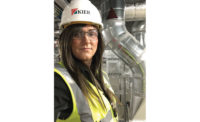The Associated General Contractors of America recently launched Culture of CARE, a program designed to boost inclusiveness and diversity in the construction industry by helping firms create more welcoming workplace environments to boost innovation, safety and profitability. ENR’s Managing Editor Scott Blair sat down (virtually) with Brynn Huneke, AGC director of diversity & inclusion and member engagement, and Brian Turmail, vice president of public affairs & strategic initiatives, to talk about what the program means for companies that sign the pledge to participate, and how the program addresses current events, such as the COVID-19 pandemic and nationwide protests to overcome racial injustices.
ENR: Can you please talk about the recent launch of Culture of CARE, which unfortunately coincided with a global pandemic?
Brynn Huneke: As you can imagine, our startup in early March right before COVID-19 really affected our launch and our strategy. We did officially launch in conjunction with our convention back in early March, and released it to our convention attendees who were in Las

Vegas with us. Recognizing that our members were trying to make sure that they were working safe and that employees were safe on the job site with respect to COVID-19, we held off on a broader kind of national launch of Culture of CARE until the end of April. Since then, we've had a great response. We've had over a hundred companies take the Culture of CARE pledge.
What are the expectations for companies that sign the pledge?
BH: The Culture of CARE pledge has four pillars that we're asking companies to commit to. CARE is an acronym that stands for commit, attract, retain, and empower. We're asking companies to commit to hire based on skill and experience, regardless of ethnicity, gender, race, nationality, religion or sexual orientation. The aim is to attract prospective employees by creating workplaces and cultures that are free from harassment, hazing and bullying; to retain high-performing employees by identifying and removing barriers to advancement; and then empower every employee to promote a culture of diversity and inclusion—or a culture of care—within their companies.
What resources do you provide to help companies follow through on their pledge?
BH: The tools and resource that are part of the website are designed to help them establish that culture of care and start to promote it within their companies. We’ve developed toolbox talks to help them talk to their employees and their subcontractors about what a culture of care means, what the expectations are. We have also drafted human resource policies and best practices, providing them resources and abilities to review and update their policies.
What are you planning for the future?
BH: It’s not meant to be a stagnant campaign. We're working on identifying training as part of the campaign, including for diversity and inclusion, implicit bias and bystander intervention so employees know how to respond if an incident happens on their job site. And we are also working on developing an assessment tool that goes more in depth into diversity and inclusion company policies. The assessment will identify areas within a company where they're lacking in diversity and inclusion and provide recommendations and best practices on how to grow in those areas.
AGC of America released a statement on the Culture of CARE site saying that “our communities are scarred and in need of healing” and that the industry has a responsibility to provide opportunities for everyone to advance and succeed. What has been the response from your members about the recent protests?
BH: I think members who have had long-standing diversity and inclusion initiatives and focus—but also companies that haven't before—recognize, with the protests that are happening in response to racial injustice throughout the country, that there is a need for construction companies to be leaders in this and care about the issue. I think there's an appetite for companies and for the industry to want to do something, to lead and make sure that our companies are an attractive place to work for everybody.
Do you see specific systemic issues in the construction industry that are holding back people of color from being hired or retained?
Brian Turmail: We’ve got a lot of communities that have never really been exposed to construction as a career option, especially in inner-city areas. It dates back to the sixties and seventies when the labor practices of this industry were called into question, and we're still struggling with that legacy. We see that manifested in the fact that we've got many urban school systems that don't have construction-focused programs. We don't have a good ability to reach those communities and recruit in them. We suffer from a lot of stereotypes and stigmas. An even bigger challenge is addressing the gender inequality on the job site, especially in the crafts. In addition to history and culture, we've also got the challenge of how to make sure that women are not harassed on job sites. And that's something that Culture of CARE hits right at. You've got to make sure that you're making a welcoming environment.

How do you ensure that word about the program gets out to everyone who needs it?
BH: One of construction's biggest challenges is its decentralized workplaces. Cultures manifest themselves differently on the job site, or even on one specific job site versus another, or versus the office within a particular company. One of the things that Culture of CARE is really trying to do, and one of the things that I am pushing when somebody takes the pledge and I'm communicating back out to them, is to make sure their employees and their subcontractors understand what a culture of care is and what the expectation for behavior is. This is in line with the toolbox talks and some of the other resources we've deployed. Also, the [Culture of CARE] hardhat stickers and job site posters are meant to be a visual reminder for anybody walking into the office or on the job site about what that expectation is, and to be a conversation starter if they've never heard of Culture of CARE.
Why did Culture of CARE develop a toolbox talk and other tools for COVID-19?
BH: In thinking about COVID-19 and the impact that it's having on companies and employees, and talking about a culture of care and diversity and inclusion, we felt there was a lot of synergy between the two. It's not just about COVID-19 as it relates to physical safety and PPE on a job site. There is a lot of fear and uncertainty, and definitely an emotional, mental and psychological toll that COVID-19 has had on all of us. So we've provided some best practices for companies to check in with their employees in an authentic way to make sure they're doing okay, not just on a physical safety level, but on a mental safety level as well. The toolbox talks also provide resources for employees who may be struggling with COVID-19 on how to access help, and that the toll it's taking on them is normal and okay and the company is there as a support system. That’s what Culture of CARE is intended to do.






Post a comment to this article
Report Abusive Comment